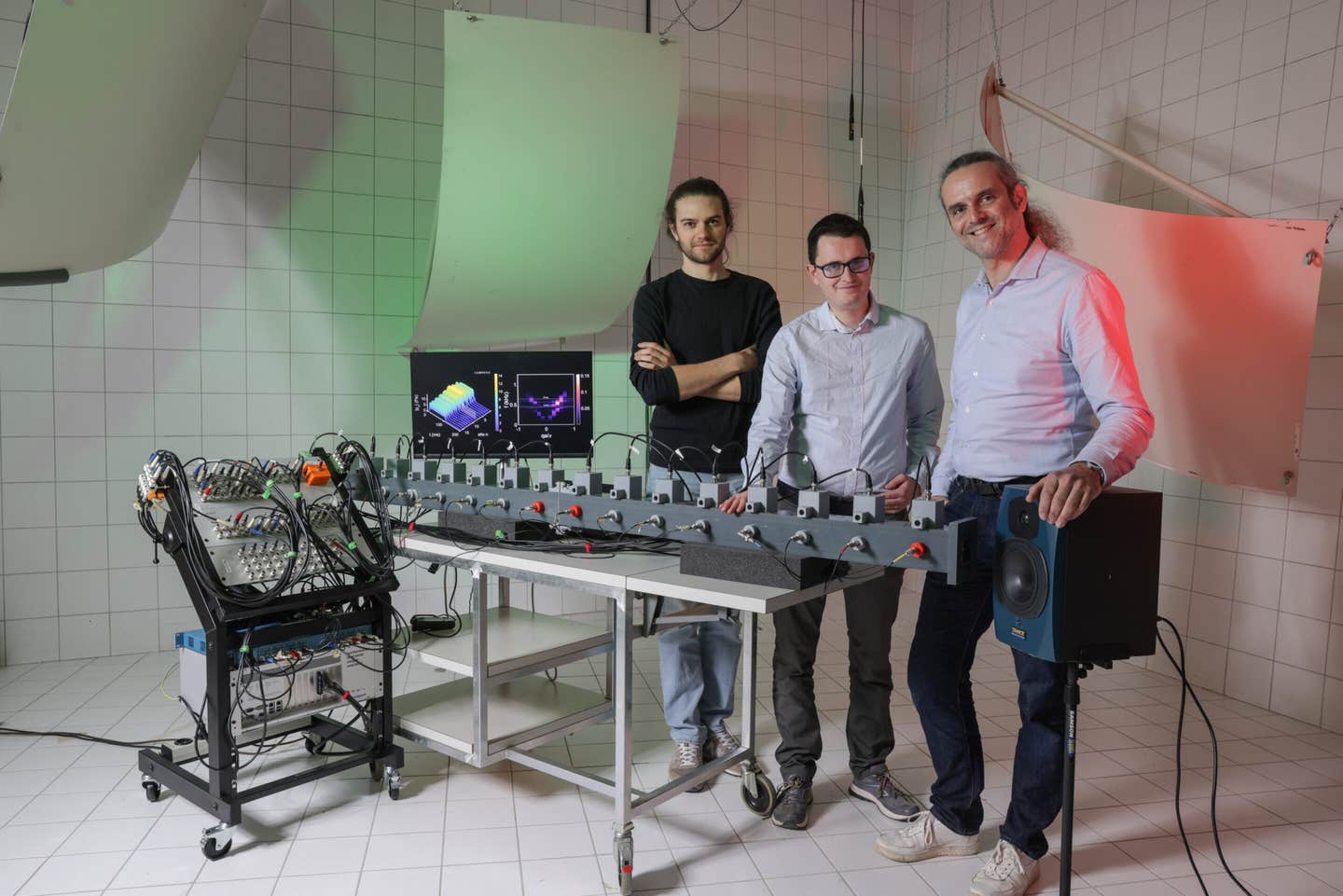Scientists use sound waves to unlock the secrets of quantum physics
A new acoustic metamaterial system mimics quantum effects, offering breakthroughs in wave control, analog computing, and sound-based modeling.

(From left to right): Mathieu Padlewski, Romain Fleury and Hervé Lissek standing with their metamaterial. (CREDIT: Alain Herzog)
A quiet revolution is taking shape in the world of physics, and it doesn’t rely on exotic particles or massive particle colliders. Instead, it begins with something much more familiar—sound. Researchers at the Swiss Federal Institute of Technology in Lausanne have designed a new acoustic system that mimics complex quantum behaviors.
Unlike traditional approaches, which struggle with the delicate nature of quantum systems, this one operates in a world we can touch and hear. The breakthrough offers new ways to study materials and could even lead to a new kind of computing.
At the heart of this development is a fascinating phenomenon called the non-Hermitian skin effect. It’s a behavior seen in certain systems where energy doesn’t spread evenly but instead piles up at the edges. In most previous experiments, scientists could only observe this effect in linear systems.
But a team has now pushed beyond that limit. By introducing nonlinearity—where the output isn’t directly proportional to the input—they’ve unlocked an entirely new set of behaviors.
Sound that defies expectations
The team extended a well-known theoretical framework known as the Hatano-Nelson model. In this updated version, the connections between components respond in a nonlinear way. As a result, waves behave differently depending on how strong the signal is. This leads to amplitude-driven localization, where the system can trap energy at different places simply by adjusting how loud the input is.
Numerical simulations backed the theory, and researchers built a working model to test their ideas. They created a highly adjustable acoustic metamaterial made of active electroacoustic resonators. These tiny elements work together to form a new kind of material with abilities far beyond what occurs in nature.
In this artificial medium, the team observed energy bunching at locations that depended on amplitude. At low levels, the energy collected in one area. When they increased the power, the energy shifted to another. This is the first time anyone has seen such control using both the skin effect and nonlinearity. It opens new paths for designing nonreciprocal devices—tools where waves move more easily in one direction than the other. These could help shape the future of communication systems or lead to energy-harvesting technologies.
Related Stories
Building a quantum playground with sound
This innovation didn’t come from quantum labs full of lasers and cryogenic cooling. It grew from frustration. PhD student Mathieu Padlewski had been trying to understand how waves behave in tightly packed atomic systems. But quantum systems are fragile. Simply measuring them can change their state. Instead of pushing through those limits, he took a different route—one that uses sound waves as stand-ins for quantum particles.
Working with researchers Hervé Lissek and Romain Fleury, Padlewski built an acoustic system to mirror complex interactions. The setup involves a line of small cubes, or "acoustic atoms." These cubes are connected so sound can pass through. Each has ports for speakers and microphones. Speakers send controlled waves, and microphones monitor the results, providing feedback.
The beauty of this system lies in how easily it adjusts. The team can change how the cubes interact or arrange them in new shapes. That makes it a ground for ideas that are hard—or impossible—to study in traditional settings.
“We’ve essentially built a playground inspired by quantum mechanics that can be adjusted to study various systems,” Padlewski explained. “Our metamaterial consists of highly tunable active elements, allowing us to synthesize phenomena that extend beyond the realm of nature.”
This approach avoids the biggest weakness in quantum research: fragility. In quantum physics, observing a system forces it to collapse into one state. This is the puzzle behind Schrödinger’s cat. Until you open the box, the cat is both alive and dead—a mix of possible outcomes. The act of looking decides the result.
But with sound, there’s no need to collapse anything. Sound waves can be measured in phase and amplitude without destroying them. In a sense, the cat stays both alive and dead, and researchers can listen in without opening the box.
Schrödinger’s cat in surround sound
Sound doesn’t just travel—it carries rich information. Think of a voice. It includes a fundamental tone and many harmonics, all layered together. This creates a superposition of sound states—a direct analog to quantum behavior. When we hear music, we don’t hear isolated tones but complex blends that our brain processes in real time. This makes sound a perfect stand-in for exploring quantum phenomena.
“Quantum probability waves are waves after all—why not model them with sound?” said Padlewski. “In acoustics, we can probe waves directly, in phase and in amplitude without destroying the state—which is nice.”
This gives scientists a way to examine behaviors similar to those in quantum physics, but without the complications that come from ultra-sensitive environments. It also allows them to test how different conditions affect those behaviors, such as the role of nonlinearity or the structure of the system.
The cube-based system Padlewski’s team created can even be scaled. While the current version is a line of 16 blocks, the same design could be used to build complex, three-dimensional structures. It’s modular, repeatable, and adaptable. In the future, it could lead to systems that function like the cochlea—the part of the ear that processes sound frequencies.
“When you see the cochlea, the ear’s organ responsible for hearing, it resembles our active acoustic metamaterial in its structure and functionality,” said Lissek. “Our metamaterial could potentially be tuned to function the same way and study hearing problems like tinnitus.”
A sound path to analog computing
Beyond modeling nature, the team’s design might help create a new kind of computing system. Padlewski envisions an acoustic analog computer—one that mirrors quantum computers in capability but works with sound. Inspired by work at other institutions, this system would use non-separable acoustic states to process information.
Quantum computers promise speed and power, but they need perfect isolation from noise. Acoustic systems, on the other hand, can handle disturbances more easily. That makes them strong candidates for solving real-world problems without needing massive support systems.
“An acoustic quantum analog computer would be more like a crystal lattice—a periodic array of cells just as atoms are arranged in crystals,” Padlewski added. “The acoustic approach to quantum computation has the potential to offer an alternate way of processing vast amounts of information simultaneously.”
The system could process data much like how atoms vibrate in a crystal or how energy moves across a structured field. This acoustic version of a quantum machine may not replace standard quantum computers, but it could offer a more practical way to explore some of the same ideas.
This opens the door to wave-based computing, where energy moves in precise patterns and carries information. These devices could help design better filters, improve signal processing, or guide energy with minimal loss. Their strength makes them especially appealing for real-world use.
As Padlewski and his team continue their work, their results suggest that sound may hold the key to understanding and controlling systems that once seemed out of reach. By tuning simple vibrations, they are crafting tools that can model, compute, and hint at future technologies.
The once-hidden behaviors of waves are now easier to explore. Through this acoustic lens, the mysteries of quantum behavior are not only more accessible—they are louder and clearer than ever.
Research findings are available online in the journal Physical Review B.
Note: The article above provided above by The Brighter Side of News.
Like these kind of feel good stories? Get The Brighter Side of News' newsletter.



